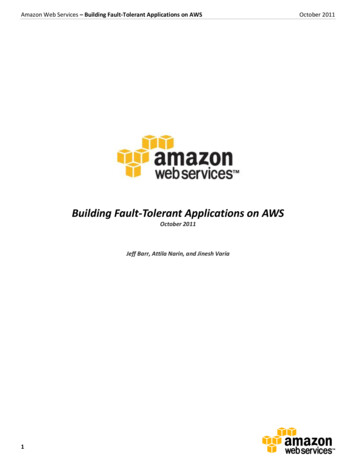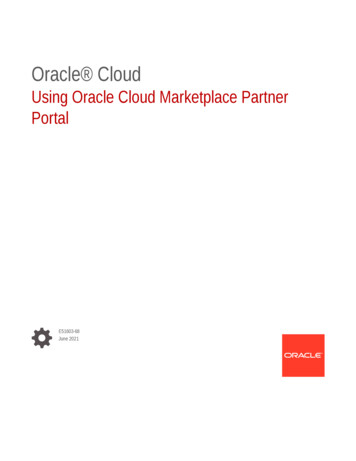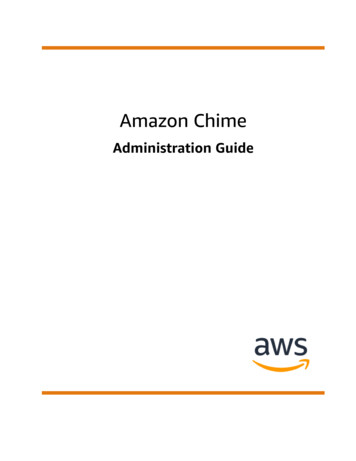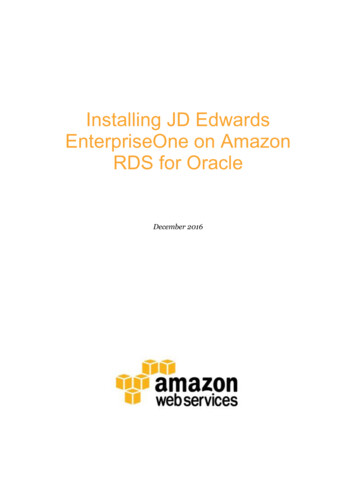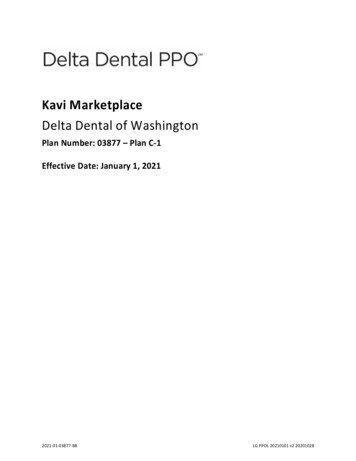
Transcription
Kavi MarketplaceDelta Dental of WashingtonPlan Number: 03877 – Plan C-1Effective Date: January 1, 20212021-01-03877-BBLG PPOL 20210101 v2 20201028
Welcome to your Dental Plan, administered by Delta Dental of Washington, a founding member of the nationwideDelta Dental Plans Association.We believe everyone can enjoy good oral and overall health, with no one left behind. It drives everything we do andhas been our sole focus for over 60 years.Your plan is a resource to make it easy for you to care for your smile. This benefit booklet summarizes your coverageand describes how your benefits may be used. Understanding your benefits is the first step to getting the most fromyour dental plan. Review this booklet before you visit your dentist and keep it for your reference.You deserve a healthy smile. We’re happy to help you protect it.Questions Regarding Your PlanIf you have questions regarding your dental benefits plan, please call or email our Customer Service Department at:800-554-1907CService@DeltaDentalWA.comWritten inquiries may be sent to:Delta Dental of WashingtonCustomer Service DepartmentP.O. Box 75983Seattle, WA 98175-0983For the most current listing of Delta Dental Participating Dentists, visit our online directory atwww.DeltaDentalWA.com or call us at 800-554-1907.Communication Access for Individuals who are Deaf, Hard of Hearing, Deaf-Blind or SpeechDisabledCommunication with Delta Dental of Washington for people who are deaf, hard of hearing, deaf-blind and/or speechdisabled is available through Washington Relay Service. This is a free telecommunications relay service provided by theWashington State Office of the Deaf and Hard of Hearing.The relay service allows individuals who use a Teletypewriter (TTY) to communicate with Delta Dental of Washingtonthrough specially trained communications assistants.Dial 711 (the statewide telephone relay number) or 800-833-6384 to connect with a Washington Relay Servicecommunications assistant. Ask them to dial Delta Dental of Washington Customer Service at 800-554-1907. They willthen relay the conversation between you and our customer service representatives.This service is free of charge in local calling areas. Calls can be made anywhere in the world, 24 hours a day, 365 days ayear, with no restrictions on the number, length or type of calls. All calls are confidential, and no records of anyconversation are maintained.2021-01-03877-BBiiLG PPOL 20210101
Table of ContentsSection A – Summary of Benefits . 1Reimbursement Levels for Allowable Benefits. 1Plan Maximum . 1How to use your Plan . 1Coinsurance . 1Benefit Period. 2Plan Maximum . 2Plan Deductible . 2Reimbursement Levels . 2Section B – Your Benefits. 3Section C – Choosing a Dentist . 13Delta Dental Participating Dentists. 13Non-Participating Dentists . 13Section D – Eligibility and Termination. 14Employee Eligibility and Enrollment . 14Employee Termination . 14Dependent Eligibility and Enrollment . 14Dependent Termination . 15Other Dependent Eligibility Topics . 15Special Enrollment Periods . 15Uniformed Services Employment & Re-Employment Rights Act (USERRA) . 17Family and Medical Leave Act (FMLA) and Paid Family Medical Leave (PFML) . 17Consolidated Omnibus Budget Reconciliation Act (COBRA) . 17Section E – Claim Review . 18Claim Forms . 18Initial Benefit Determinations. 18Appeals of Denied Claims . 18How to Report Suspicion of Fraud . 19Your Rights and Responsibilities . 19Health Insurance Portability and Accountability Act (HIPAA) . 20Conversion Option . 20Extension of Benefits . 20Coordination of Benefits . 21Subrogation . 25Section F - Resources . 26Frequently Asked Questions about Your Dental Benefits . 26Glossary . 27Nondiscrimination and Language Assistance Services . 322021-01-03877-BBiiiLG PPOL 20210101
Section A – Summary of BenefitsReimbursement Levels for Allowable BenefitsIn-Network – Delta Dental PPO DentistsClass I . 100%Class II . 80%Class III . 50%Annual Deductible per Person . 50Annual Deductible — Family Maximum . 150Out-of-Network – Non-ParticipatingClass I . 80%Class II . 70%Class III . 40%Annual Deductible per Person . 50Annual Deductible — Family Maximum . 150Plan MaximumAnnual Plan Maximum per Person* . 2,000*Class I Covered Dental Benefits do not accrue towards the Annual Plan Maximum.The payment level for covered dental expenses arising as a direct result of an accidental injury is 100 percent, up to theunused Plan Maximum.All Enrolled Employees and Enrolled Dependents are eligible for Class I, Class II, Class III Covered Dental Benefits, andaccidental injury benefits.The annual deductible is waived for: Class I Covered Dental Benefits. Accidental Injury Benefits.How to use your PlanThe best way to take full advantage of your dental Plan is to know its features. You can learn them by reading thisbenefit booklet before you go to the dentist. This benefit booklet is designed to give you a clear understanding of howyour dental coverage works and how to make it work for you. It also answers some common questions. If you havequestions or do not understand something please give us a call at 800-554-1907. We’re more than happy to help.Consult your provider regarding any charges that may be your responsibility before treatment begins.CoinsuranceDDWA will pay a percentage of the cost of your treatment and you are responsible for paying the allowable balance.The part you pay is called the coinsurance. If your plan has a deductible, you are responsible for the coinsurance evenafter a deductible is met.2021-01-03877-BB1LG PPOL 20210101
Please see your “Reimbursement Levels for Allowable Benefits” under the “Summary of Benefits” section for details onthe coinsurance required by your plan.Benefit PeriodMost dental benefits are calculated within a “benefit period,” which is typically for one year. For this Plan, the benefitperiod is the 12-month period starting the first day of January and ending the last day of December.Plan MaximumThe Plan Maximum is the maximum dollar amount DDWA will pay toward the cost of dental care within a specificbenefit period. The maximum amount payable for Covered Dental Benefits in each benefit period is listed in the“Summary of Benefits” section in this booklet.Charges for dental procedures requiring multiple treatment dates are considered incurred on the date the services arecompleted, also known as the seat date. Amounts paid for such procedures will be applied to the Plan Maximum basedon the incurred date.Plan DeductibleYour Plan has a deductible, which can be found in the “Summary of Benefits” section. This means that from the firstpayment or payments DDWA makes for Covered Dental Benefits, a deduction is taken. This deduction is owed to theprovider by you. Once an Enrolled Person has satisfied the deductible during the benefit period, no further deductionwill be taken for that Enrolled Person until the next benefit period.Your family maximum is also listed in the “Summary of Benefits” section. Once a family has satisfied the maximumdeductible amount during the benefit period, no further deduction will apply to any member of that family until thenext benefit period.Reimbursement LevelsYour dental Plan offers different classes of covered treatment. Each class also specifies limitations and exclusions. Formore information about reimbursement levels for your plan, see the “Summary of Benefits” section in the front of thisbenefit booklet.Refer to the “Benefits Covered by Your Plan” section of this benefit booklet for specific Covered Dental Benefits underthis Plan.2021-01-03877-BB2LG PPOL 20210101
Section B – Your BenefitsBenefits Covered By Your PlanThe following are the Covered Dental Benefits under this Plan and are subject to the limitations and exclusions (referalso to “General Exclusions” section) contained in this benefit booklet. Such benefits (as defined) are available onlywhen provided by a licensed dentist or other licensed professional when appropriate and necessary as determined bythe standards of generally accepted dental practice and DDWA.Note: Please be sure to consult your provider before treatment begins regarding any charges that may be yourresponsibility.The amounts payable by DDWA for Covered Dental Benefits are described on your “Summary of Benefits” section ofthis benefit booklet.Class I BenefitsClass I DiagnosticCovered Dental Benefits Comprehensive, or detailed and extensive oral evaluation. Diagnostic evaluation for routine or emergency purposes (dental exam). X-rays.Limitations Comprehensive, or detailed and extensive oral evaluation is covered once in the patient’s lifetime by the samedentist. Subsequent comprehensive or detailed and extensive oral evaluations from the same dentist are paidas a periodic oral evaluation. Routine evaluation is covered twice in a benefit period. Routine evaluation includes all evaluations exceptlimited problem-focused evaluations. Limited problem-focused evaluations are covered twice in a benefit period. Bitewing x-rays are covered once in a benefit period. A complete series or panoramic x-ray is covered once in a five-year period from the date of service. Any number or combination of x-rays, billed for the same date of service, which equals or exceeds theallowed fee for a complete series, is considered a complete series for payment purposes.Exclusions Consultations – diagnostic services provided by a dentist other than the requesting dentist. Study models. Diagnostic services and x-rays related to temporomandibular joints (jaw joints) are not a Class I paid CoveredDental Benefit.Class I PreventiveCovered Dental Benefits Prophylaxis (cleaning). Periodontal maintenance. Topical application of fluoride including fluoridated varnishes. Sealants. Space maintainers.2021-01-03877-BB3LG PPOL 20210101
Preventive resin restoration.Limitations Any combination of prophylaxis (cleaning) and periodontal maintenance is covered twice in a benefit period. Periodontal maintenance procedures are covered only if a patient has completed active periodontaltreatment. For any combination of adult prophylaxis (cleaning) and periodontal maintenance, third and fourthoccurrences may be covered if your gums have Pocket depth readings of 5mm or greater.* Topical application of fluoride is limited to two covered procedures in a benefit period. The application of a sealant is a Covered Dental Benefit once in a two-year period per tooth from the date ofservice. Benefit coverage for application of sealants is limited to permanent molars that have no restorations(includes preventive resin restorations) on the occlusal (biting) surface. Space maintainers are covered once in a patient’s lifetime through age 17 for the same quadrant. The application of a preventive resin restoration is a Covered Dental Benefit once in a two-year period pertooth from the date of service. Payment for a preventive resin restoration will be for permanent molars with no restorations on theocclusal (biting) surface. The application of a preventive resin restoration is not a Covered Dental Benefit for two years after asealant or preventive resin restoration on the same tooth.*Note: These benefits are available only under certain conditions of oral health. It is strongly recommended that youhave your dentist submit a Confirmation of Treatment and Cost request to determine if treatment is a covered dentalbenefit. A Confirmation of Treatment and Cost is not a guarantee of payment. See the “Confirmation of Treatment andCost” section for additional information.Exclusions Plaque control program (oral hygiene instruction, dietary instruction and home fluoride kits).Class I PeriodonticsCovered Dental Benefits Prescription-strength fluoride toothpaste. Prescription-strength antimicrobial rinses.Limitations Prescription-strength fluoride toothpaste and antimicrobial rinse are Covered Dental Benefits followingperiodontal surgery or other covered periodontal procedures when dispensed in a dental office. Proof of a periodontal procedure must accompany the claim or the patient’s history with DDWA must show aperiodontal procedure within the previous 180 days. Prescription-strength antimicrobial rinse may be dispensed once per course of periodontal treatment, whichmay include several visits. Prescription-strength antimicrobial rinse is available for women during pregnancy without any periodontalprocedure.2021-01-03877-BB4LG PPOL 20210101
Class II BenefitsClass II SedationCovered Dental Benefits General anesthesia. Intravenous moderate sedation.Limitations General anesthesia is a Covered Dental Benefit only in conjunction with certain covered endodontic,periodontic and oral surgery procedures, as determined by DDWA, or when medically necessary, for childrenthrough age six, or a physically or developmentally disabled person, when in conjunction with Class I, II and IIICovered Dental Benefits.* Intravenous moderate sedation is covered in conjunction with certain covered endodontic, periodontic andoral surgery procedures, as determined by DDWA.* Sedation, which is either general anesthesia or intravenous moderate sedation, is a Covered Dental Benefitonly once per day.*Note: These benefits are available only under certain conditions of oral health. It is strongly recommended that youhave your dentist submit a Confirmation of Treatment and Cost request to determine if the treatment is a covereddental benefit. A Confirmation of Treatment and Cost is not a guarantee of payment. See the “Confirmation ofTreatment and Cost” section” for additional information.Exclusions General anesthesia or intravenous moderate sedation for routine post-operative procedures is not a paidCovered Dental Benefit except as described above for children through the age of six or a physically ordevelopmentally disabled person.Class II Palliative TreatmentCovered Dental Benefits Palliative treatment for pain.Limitations Postoperative care and treatment of routine post-surgical complications are included in the initial cost forsurgical treatment if performed within 30 days.Class II RestorativeCovered Dental Benefits Restorations (fillings). Stainless steel crowns.Limitations Restorations on the same surface(s) of the same tooth are covered once in a two-year period from the date ofservice. Restorations are covered for the following reasons: 2021-01-03877-BBTreatment of carious lesions (visible destruction of hard tooth structure resulting from the process ofdental decay).5LG PPOL 20210101
Fracture resulting in significant loss of tooth structure (missing cusp). Fracture resulting in significant damage to an existing restoration. If a resin-based composite or glass ionomer restoration is placed in a posterior tooth (except those placed inthe buccal (facial) surface of bicuspids), it will be considered an elective procedure and an amalgam allowancewill be made, with any difference in cost being the responsibility of the patient. Stainless steel crowns are covered once in a two-year period from the date of service.Exclusions Overhang removal. Copings. Re-contouring or polishing of a restoration. Restorations necessary to correct vertical dimension or to alter the morphology (shape) or occlusion.Please also see: Refer to “Class III Restorative” for more information regarding coverage for crowns (other than stainless steel),inlays, veneers or onlays.Class II Oral SurgeryCovered Dental Benefits Removal of teeth. Preparation of the mouth for insertion of dentures. Treatment of pathological conditions and traumatic injuries of the mouth.Exclusions Bone replacement graft for ridge preservation. Bone grafts, of any kind, to the upper or lower jaws not associated with periodontal treatment of teeth. Orthognathic surgery or treatment. Tooth transplants. Materials placed in tooth extraction sockets for the purpose of generating osseous filling.Please also see: “Class II Sedation “section for additional information.Class II PeriodonticsCovered Dental Benefits Surgical and nonsurgical procedures for treatment of the tissues supporting the teeth. Periodontal scaling/root planing. Periodontal surgery. Limited adjustments to occlusion (eight teeth or fewer). Localized delivery of antimicrobial agents.* Gingivectomy.Limitations Periodontal scaling/root planing is covered once in a 36-month period from the date of service.2021-01-03877-BB6LG PPOL 20210101
Limited occlusal adjustments are covered once in a 12-month period from the date of service. Periodontal surgery (per site) is covered once in a three-year period from the date of service. Periodontal surgery must be preceded by scaling and root planing done a minimum of six weeks anda maximum of six months prior to treatment, or the patient must have been in active supportiveperiodontal therapy. Soft tissue grafts (per site) are covered once in a three-year period from the date of service. Localized delivery of antimicrobial agents is a Covered Dental Benefit under certain conditions of oral health,such as periodontal Pocket depth readings of 5mm or greater.* When covered, localized delivery of antimicrobial agents is limited to two teeth per quadrant and upto two times (per tooth) in a benefit period. When covered, localized delivery of antimicrobial agents must be preceded by scaling and rootplaning done a minimum of six weeks and a maximum of six months prior to treatment, or thepatient must have been in active supportive periodontal therapy.*Note: Some benefits are available only under certain conditions of oral health. It is strongly recommended that youhave your dentist submit a Confirmation of Treatment and Cost request to determine if the treatment is a CoveredDental Benefit. A Confirmation of Treatment and Cost is not a guarantee of payment. See the “Confirmation ofTreatment and Cost “section for additional information.Please also see: “Class I Preventive” section for prophylaxis (cleaning) benefits. “Class II Sedation” section for additional information. “Class III Periodontics” section for complete occlusal equilibration or occlusal guard.Class II EndodonticsCovered Dental Benefits Procedures for pulpal and root canal treatment, including pulp exposure treatment, pulpotomy, andapicoectomy.Limitations Root canal treatment on the same tooth is covered once in a two-year period from the date of service. Re-treatment of the same tooth is allowed only when performed by a dentist other than the dentist whoperformed the original treatment and only if the re-treatment is performed in a dental office other than theoffice where the original treatment was performed.Exclusions Bleaching of teeth.Please also see: “Class II Sedation” section for additional information.2021-01-03877-BB7LG PPOL 20210101
Class III BenefitsClass III PeriodonticsThese benefits are available for patients with periodontal Pocket depth readings of 5mm or greater only, as determinedby your dentist. It is strongly recommended that prior to treatment you have your dentist submit a Confirmation ofTreatment and Cost to determine if the planned treatment is a Covered Dental Benefit. A Confirmation of Treatmentand Cost is not a guarantee of payment.Covered Dental Benefits Occlusal-guard (nightguard). Repair and relines of occlusal-guard. Complete occlusal equilibration.Limitations Occlusal-guard is covered once in a three-year period from the date of service. Repair and relines done more than six months after the date of initial placement are covered. Complete occlusal equilibration is covered once in a lifetime.Class III RestorativeCovered Dental Benefits Crowns, veneers, and onlays for treatment of carious lesions (visible destruction of hard tooth structureresulting from the process of removing dental decay) or fracture resulting in significant loss of tooth structure(e.g., missing cusps or broken incisal edge). Crown buildups. Post and core on endodontically-treated teeth. Implant-supported crown.Limitations A crown, veneer, or onlay on the same tooth is covered once in a seven-year period from the seat date. An implant-supported crown on the same tooth is covered once in a seven-year period from the original seatdate of a previous crown on the same tooth. An inlay (as a single tooth restoration) will be considered as elective treatment and an amalgam allowance willbe made, with any difference in cost being the responsibility of the Enrolled Person, once in a two-year periodfrom the seat date. Payment for a crown, veneer, inlay, or onlay shall be paid based upon the date that the treatment orprocedure is completed. A crown buildup is covered for a non-endodontically treated posterior (back) tooth only when one cusp ismissing down to, or closer than, 2mm from the gum tissue in preparation for a restorative crown. A crown buildup is covered for an endodontically or a non-endodontically treated anterior (front) tooth onlywhen more than 1/2 of the mesial-distal width of the incisal edge is missing down past the junction of theincisal and middle third of the tooth in preparation for a restorative crown. A crown buildup is covered once in a seven-year period on the same tooth from the date of service. A post and core is covered once in a seven-year period on the same tooth from the date of service. Crown buildups or post and cores are not a paid Covered Dental Benefit within two years of a restoration onthe same tooth from the date of service.2021-01-03877-BB8LG PPOL 20210101
A crown used for purposes of re-contouring or repositioning a tooth to provide additional retention for aremovable partial denture is not a paid Covered Dental Benefit unless the tooth is decayed to the extent that acrown would be required to restore the tooth whether or not a removable partial denture is part of thetreatment.Exclusions Copings. A core buildup is not billable with placement of an onlay, 3/4 crown, inlay or veneer. A crown or onlay is not a paid Covered Dental Benefit when used to repair micro-fractures of tooth structurewhen the tooth is asymptomatic (displays no symptoms) or there is an existing restoration with no evidence ofdecay or other significant pathology. A crown or onlay placed because of weakened cusps or existing large restorations.Class III ProsthodonticsCovered Dental Benefits Dentures. Fixed partial dentures (fixed bridges). Inlays when used as a retainer for a fixed partial denture (fixed bridge). Removable partial dentures. Adjustment or repair of an existing prosthetic appliance. Surgical placement or removal of implants or attachments to implants.Limitations Replacement of an existing fixed or removable partial denture is covered once every seven years from thedelivery date and only then if it is unserviceable and cannot be made serviceable. Payment for dentures, fixed partial dentures (fixed bridges), inlays (only when used as a retainer for a fixedbridge), and removable partial dentures shall be paid upon the seat/delivery date. Implants and superstructures are covered once every seven years. Temporary Denture - DDWA will allow the amount of a reline toward the cost of an interim partial or fulldenture. After placement of the permanent prosthesis, an initial reline will be a benefit after six months. Denture adjustments and relines – Denture adjustments and relines done more than six months after theinitial placement are covered. Subsequent relines or rebases (but not both) will be covered once in a 12
your dental coverage works and how to make it work for you. It also answers some common questions . If you have . y ou are responsible for the coinsurance even after a deductible is met. 2021-01-03877-BB 2 LG PPOL 20 210101 . Plaque contr ol program (oral hygiene instruction, dietary instruction and home fluoride kits) .


![Index [beckassets.blob.core.windows ]](/img/66/30639857-1119689333-14.jpg)
